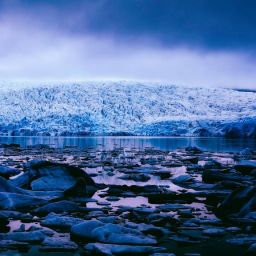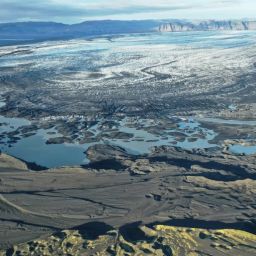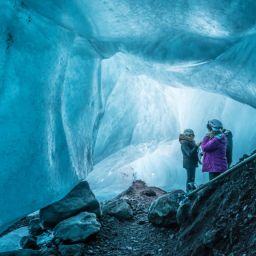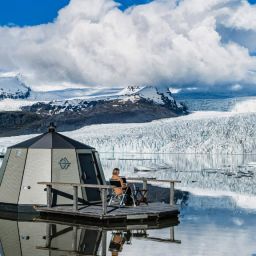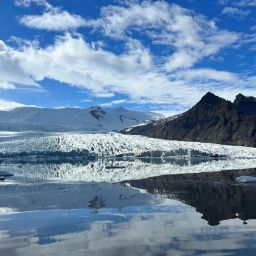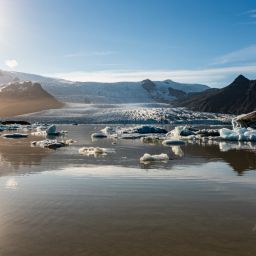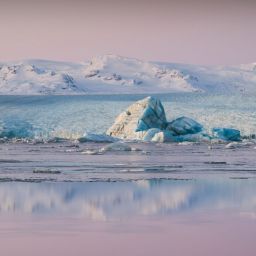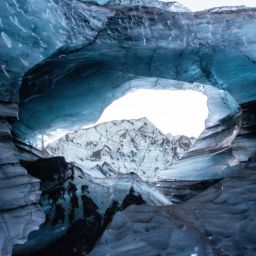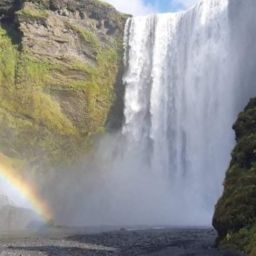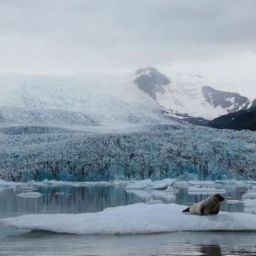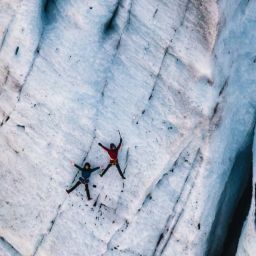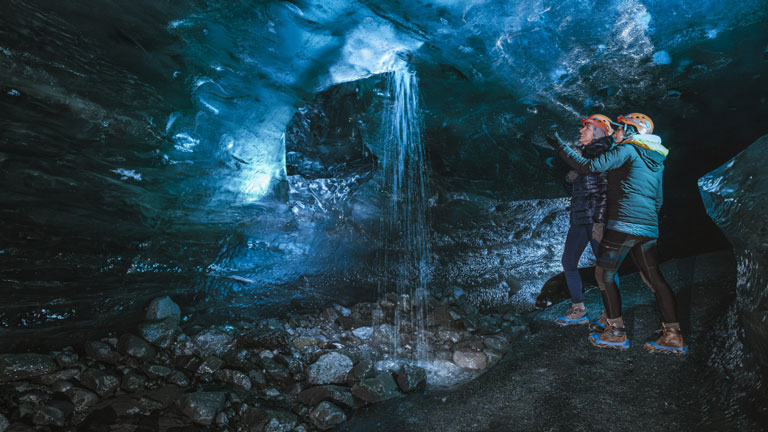
Iceland’s glaciers and ice caves are melting at an alarming rate.
By their very definition, ice caves in Iceland, as with those anywhere else in the world, are constantly in a state of flux. During the warmer months, meltwater finds its way into cracks and crevasses in the ice, carving out tunnels and cavernous spaces within the main body of the glacier. As the seasons advance and the temperatures fall, the ice stabilises, hardening into ice caves and other glacial landforms.
It’s a process that has been the norm for centuries, and it’s also the reason why many of these impressive landforms are only safe to access for part of the year. Yet the number and nature of ice caves, as well as the timeframe impacting visits, are shifting, as variations in the climate become more pronounced. In this article we’ll take a look at what’s happening, why Iceland’s ice caves are changing and the impact of melting glaciers.

Higher average temperatures have a detrimental effect on the glaciers.
The greenhouse effect and its link to climate change in Iceland and the wider Arctic region
For a century, temperatures in Iceland have been on a warming trend. According to a report published by the Icelandic Met Office, things are ramping up. Since 1980, temperatures have risen by 0.47C each decade, a rate that exceeds the global average. The “good news” – as far as Vatnajokull is concerned anyway – is that the worst affected areas of the country are in the west and north west of the country.
It’s widely believed that the rapid rate of rising temperatures has occurred as a result of human activity. In what’s known as the greenhouse effect, concentrations of water vapour, carbon dioxide and other gases such as methane build up in the Earth’s atmosphere. Sunlight that should be bounced back because of radiation is instead absorbed by these gases.
This heat is effectively trapped, causing the air below it to be warmed as it radiates back. Yet we need this process to some extent – without the greenhouse effect the Earth’s temperature would average −18°C. It’s the speed at which things are changing that’s the problem; since the Industrial Revolution methane levels have doubled and there’s about 30% more carbon dioxide.
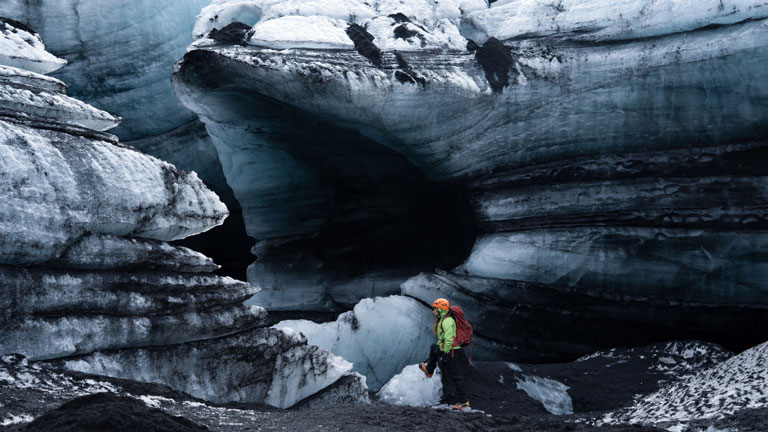
Black ash covers large parts of Iceland’s glaciers.
Global warming trends should not be taken lightly. The Arctic is experiencing rates of change in excess of other parts of the world. In a process known as Arctic amplification, the loss of ice through melting means that there are fewer lighter coloured surfaces – what was once ice is now rock or darker ocean water.
These darker surfaces absorb more heat from the sun instead of reflecting it back into the atmosphere, which accelerates the rate of warming. More ice is lost as temperatures creep up, which in turn increases the amount of darker areas. Scientists are studying the extent of ice across the Arctic region; one alarming prediction suggests an ice-free September could be a reality in less than a quarter of a century.
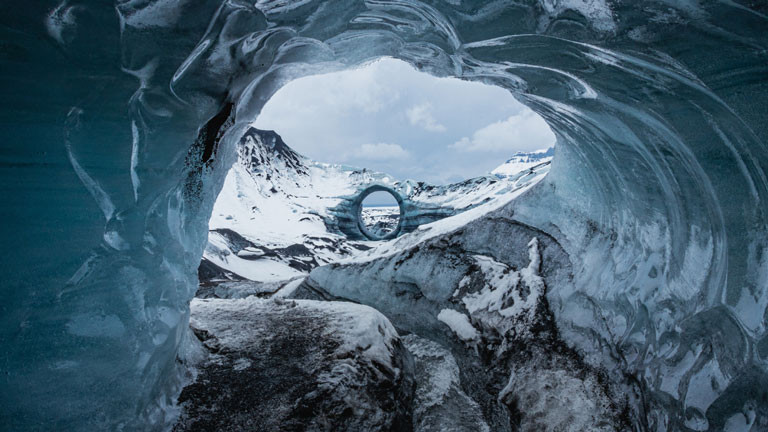
View from one ice cave to an ice tube on one of Iceland’s largest glaciers, Mýrdalsjökull.
The predicament of Iceland’s glaciers
Iceland’s proximity to this vulnerable region and the presence of so many glaciers, means that it will continue to be affected going forward. Smaller glaciers are already being severely impacted, not least Okjökull which was formally declared “dead” a few years back – no longer officially having the status of a glacier.
According to the Icelandic Met Office, the country’s glaciers reached their maximum extent at the end of the 19th century. Since then, they have been in retreat, especially in the last quarter of a century. However, this concerning pattern was actually interrupted in the 1960s when the glaciers advanced for a time. By the 1990s, however, an estimated 90% of Iceland’s glaciers were in retreat once more.
Forecasts for future volume loss are worrying. By the end of this century, it’s feared that Langjökull could have lost as much as 85% of its ice. Because of its larger volume, Vatnajökull fares better, but the rate of ice loss is still huge. Predictions indicate that it could shrink by as much as 60% over the same period. If that’s the case, then the number of ice caves will shrink, quite simply because there will be less ice for them to form within.

A blue ice cave in Vatnajökull glacier, Europe’s largest glacier.
Assessing risk
In most cases, as with Vatnajökull, the typical rise in temperatures during the summer can make ice caves unstable. The increase in meltwater in this season can have a destabilising effect on the ice. The most extreme consequence associated with this is that the roof of an ice cave actually collapses causing the landform to cave in, putting the lives of tourists and their guides at risk. Where this is a possibility, therefore authorities act to ensure legislation and regulations are in place to keep everyone as safe as possible.
The authorities managing Vatnajokull National Park (now under the jurisdiction of the Nature Conservation Agency of Iceland) instigated a series of measures in 2017, including a strong recommendation that its ice caves should remain off limits during the summer months.
At the time, the University of Iceland’s Faculty of Earth Sciences risk assessed ice caves tours in this locality and recommended a system classifying a visit as red (unsafe) or green (low risk). Tour operators wishing to run ice cave tours, such as us, must now follow the recommendations.
New contracts for tour operators began on November 1st 2024. In addition to a generalised risk assessment, operators are required to carry out daily risk assessments before escorting visitors to the glacier. When browsing tours and choosing which operator to book with, it’s a question that travellers should ask. Reputable providers such as Fjallsárlón will be happy to reassure potential bookers that the necessary checks have taken place before the activity gets underway.
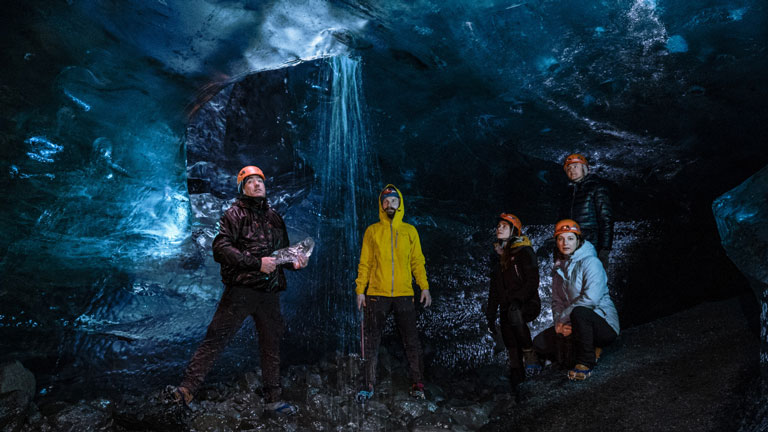
The best season for ice cave tour in Iceland is November to April.
The season for ice caves visits is shifting
Going forward, across the globe, climate change will continue to alter weather patterns and as this progresses, Iceland is likely to experience not only warmer temperatures but also variations in other aspects of its climate such as rainfall patterns. Authorities – and by extension tour operators – will need to stay abreast of such long term changes and act accordingly.
Though smaller glaciers will be under the greatest threat of receding and even disappearing completely over the coming decades, the vast body of ice that comprises Vatnajökull glacier will exist for longer, even if it is likely that it will eventually be thinner and smaller. Everyone, from scientists and governments to visitors and tour operators, is watching closely.
The most likely outcome for any glacier-based activities at the fringes of a glacier, such as ice hikes and ice cave tours, will be that the season in which they are possible will be compressed. To experience the magic of being under the ice in a semi-translucent cavern will be restricted to a shorter season within late autumn, winter and early spring. At some point in the future it will most likely only be an option in the coldest part of winter.
It’s a worrying time for Iceland, whose glaciers and by extension its ice caves form such an important part of the landscape. Here at Fjallsárlón, we watch and wait as these beautiful landforms face an uncertain future.



